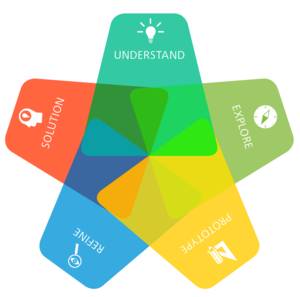This article is part of a series. Understand is #1 of 5.
Design is a hot topic now and pops up in casual conversation all the time. The industry as a whole, and design education specifically, have experienced significant changes over the past decade. Former clear lines between creative disciplines have become blurry and some have disappeared. Technology and globalization have changed how we interact and communicate, and both demand and expectation are high for what the future holds.
A decade ago, designers and design educators were a select breed. We were artists; design was our game. Today, designers and design educators are less distinguishable, and we’re often proficient in not only design; our competencies and collaboration glide from business and marketing strategy to research to content strategy, and more.
We’re expert problem solvers, and we deliver high quality, end-to-end experiences for products and services. We hail from a variety of disciplines, even outside of design, and together we leverage cross-functional perspectives to excel and delight.
And guess what? Designers and design educators are in high demand. For those of you who have survived the broadening of this practice, I commend you. But even more credit to those of you who have adapted and have taken the initiative to learn the new skills required to excel as a designer or educator today.
I’m a classically trained Graphic Designer. I’ve spent time in Creative Direction, and I’ve tackled User Experience and Product Design. I now lead my own Design & Strategy firm specialized in human-centered research and development. We offer full service and a la carte solutions that help businesses grow. We’ve learned from these years of design transition; we need to approach design differently. Design isn’t only about taking and solving the obvious problems and addressing them in a design silo; it’s about applying design thinking into the broader education and business environment. Empathy is the key. This is the new face of design.
In this blog series, I walk you through practical exercises of User Centered Design and Design Thinking processes that you can implement to refine your own processes. Use them as resources to integrate design thinking as a framework in the activities that follow and/or apply them to any project you choose. In combination with the many Design Academy resources these exercises are helpful for those new to Design Thinking and those wishing to refine their process.
This series covers the five steps of User Centered Design and the Design Thinking process. These steps— Under- stand, Explore, Prototype, Refine, and Solution—are not only what I use day-to-day, but also what I teach at the Academy of Art University and California College of the Arts in San Francisco. I truly believe this process is integral in exceeding the new expectations of design, for all of us. There is no better time than now to master these skills. Our commitment to these practices can drive sustainable, positive change —socially, economically, behaviorally, and more—on both small and large scales.
This series also includes several homework assignments for students of various levels and encourages hands-on practice. These assignments teach how to understand the people you’re designing for, how to generate ideas, how to prototype them, how to solicit feedback, and ultimately how to lead to innovate. They also help you build class interaction and peer-to-peer learning skills to foster a collaborative environment and the collaborative and interdisciplinary skills to succeed as a Design Thinker.
Let’s get to it. While there are various interpretations of the key steps in design thinking, Autodesk promotes the following:
Understand—Understanding involves learning about the problem and the intended audience by developing empathy to uncover people’s wants and needs.
Explore—Exploring is about generating a wide range of ideas on how we might meet the needs of the people for whom we’re designing.
Prototype—Prototyping is a form of validating and testing (and iterating and testing again) to gather constructive and timely feedback at an early stage in order to apply learnings back into product or service improvements.
Refine—Refining involves narrowing your ideas down to one and making final refinements.
Solution—Solutions entail building, printing, or presenting the finished project.
Understanding the people you’re designing for—the ones who will use your products and services—is the crucial first step. We call them “users,” but let’s be honest: they’re people. Developing empathy for people is not only a pillar of design thinking, but essential throughout the whole process. We must uncover people’s true wants and needs in order to understand and frame the problem we’re solving. By placing people at the forefront of our approach, and by removing our own bias, we unearth the learnings that will guide our process. Understanding encompasses the study of these people, the empathy we develop, and the findings that emerge. This is the most foundational and important phase of this methodology. Design thinking does not start with a problem or a solution. It is implementing this preliminary step that truly differentiates design thinking from a traditional design approach.
Pretty basic, right? It’s putting people first so we can learn about their needs and expose problems we can solve through design. But how?
There are many methods to gain this understanding, both active and passive. Passive approaches might include artifact analyses and simple observation. Active approaches could include interviews, diary studies, or card sorting.
Let’s take a look at an example from each of these. Let’s say you’ve been hired to design chairs for toddlers. You might employ simple observation, a passive method. You might learn that a challenge faced by young ones in moving from surface to surface is affected by height or slope. You might learn that stability is a key factor in reducing falls. You might learn that color affects delight. You also could take an active approach. Perhaps you interview mothers of toddlers to understand their pain points for chairs, and learn that being easily cleaned is of utmost importance, or that growing as the child does would be a nice to have.
A combination of approaches is usually the most reliable, but isn’t always possible due to time, geography, budget, or general resources. Let’s say you’re studying how people use cash cards in Europe, but your budget doesn’t include a trip to Europe. While you might not be able to do artifact analyses, such as studying cash machines used in London, you might be able to interview people who have used them on a regular basis.
Whatever approach or approaches you employ, it’s essential that you take the mass of information and data you’ve collected and take the time to analyze it. Look for patterns and themes. Take a step back and look again. Be cautious of outliers. Findings are nothing without synthesis.
Understanding is the most foundational phase of the five. It might be tempting to skip this phase if you think you already have a general understanding, but remember that our own biases and assumptions are quick to get in the way of empathy. If we don’t take time to be thorough in this crucial phase, we run the risk of taking a turn that leads the entire design process in the wrong direction. We want to uncover the most impactful wants and needs, and we will keep coming back to these in the next few steps.
Now, let’s give this a whirl. In this design thinking assignment, the objective is to develop and refine skills in Understanding using the Autodesk Design Academy Chair-Ergonomics as the design project. This assignment, together with the featured project designer, Karim Rashid, and the project resources integrate design thinking as a framework that can be applied to any project regardless of the level of talent. They are also designed to connect you to the Design Academy community. We encourage you to post, share, and celebrate your progress along the way.









